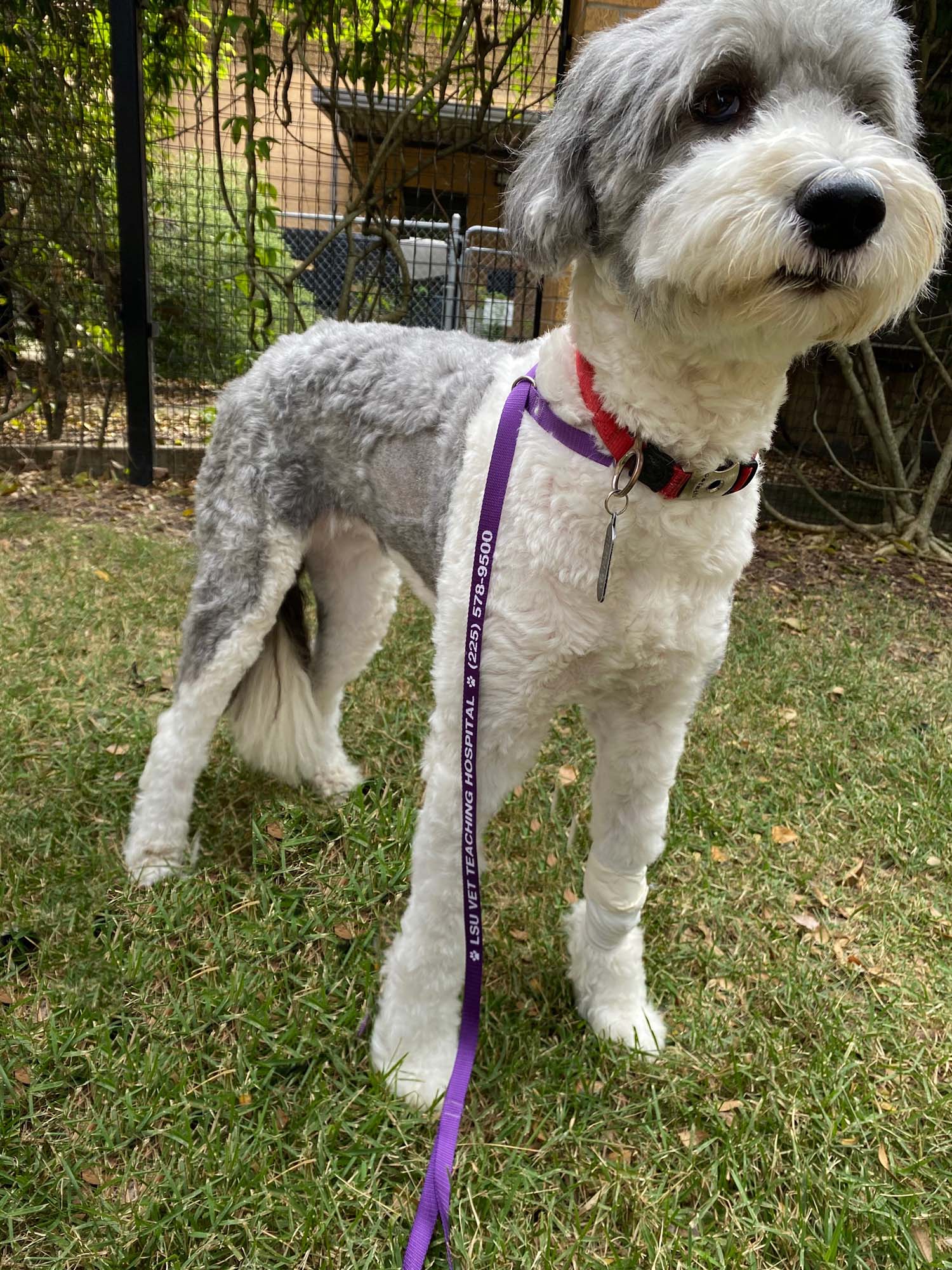Paralyzed dog walks again after just days of therapy at LSU Vet Med

Originally published January 14, 2022
Keitha and Keith Marcotte of Shreveport, La., were vacationing in Florida when the couple received a phone call from their dog sitter with awful news. Shelby, their five-year-old English sheep dog-poodle mix, had collapsed while chasing a ball down a hill. Severely injured, she was unable to stand up. Because he could get to Shelby first, their son drove from Dallas to Shreveport to pick her up and bring her to the LSU School of Veterinary Medicine.
Hind limbs paralyzed, Shelby was diagnosed with a spinal cord injury, fibrocartilaginous embolism, or FCE, which happens when a piece of cartilage from a disk blocks blood flow to the spinal cord. The Marcottes were afraid she would never walk again. As long as the spinal cord hadn’t died, blood flow and nerve function could return. An FCE diagnosis would offer a better chance of recovery than other types of spinal disc injuries.
When Shelby arrived at LSU Vet Med on Oct. 18, 2021, she was wheeled into the Emergency and Critical Care Service, evaluated, and given an MRI. Dr. Daniel McCarthy, small animal surgery resident, further evaluated Shelby and determined, at best, she had a 50-50 chance of walking again.
“Sadly, there was no surgical remedy for Shelby,” Keitha said.
The couple decided to have Shelby seen by LSU Vet Med’s Integrative Medicine Service, where she underwent in-patient treatment for five days.
“The sooner we could get her in the hyperbaric oxygen chamber, the better chance for her recovery,” said Lorrie Hale, DVM, MS, CVTCM, assistant professor of integrative medicine and rehabilitation, who is certified in veterinary acupuncture, Tui-na, Chinese herbal medicine, and food therapy, which makes her one of the few certified traditional Chinese veterinary medicine practitioners in the world.
The hyperbaric chamber allows more oxygen to get into the tissue, helping the body to heal. Oxygen is needed to support cellular function.
Prior to her first hyperbaric oxygen treatment, Shelby was not able to stand. During the second day of treatment, she could stand but not walk. The following day’s treatment saw her standing but with minimal movement in her hips. Dr. Hale administered acupuncture and rehabilitation treatments, including the underwater treadmill. The next day, she had movement in her right hip, and the following day she was walking with support.
“Shelby is further along than I ever expected her to be,” Dr. Hale said.
Dr. Hale has successfully treated three dogs with injuries similar to Shelby’s. All three are walking again.
After only two weeks of treatment, she made a remarkable recovery and is now continuing acupuncture and rehab closer to home in Shreveport.
“We are so grateful for the expertise of the entire LSU Vet Med team—and especially Dr. Hale,” Keitha said.
Also serving on Shelby’s clinical team and providing excellent basic care were fourth-year students Allison Searcy, Kristel Echevarria, Kayla Fontenot, Paige Reagan (who were all taking part in their integrative medicine rotation), and Michael Polick (who was taking part in his surgery rotation).
LEARN ABOUT OUR INTEGRATIVE MEDICINE SERVICE
Writer
Sandra Sarr, MFA
Communications Manager